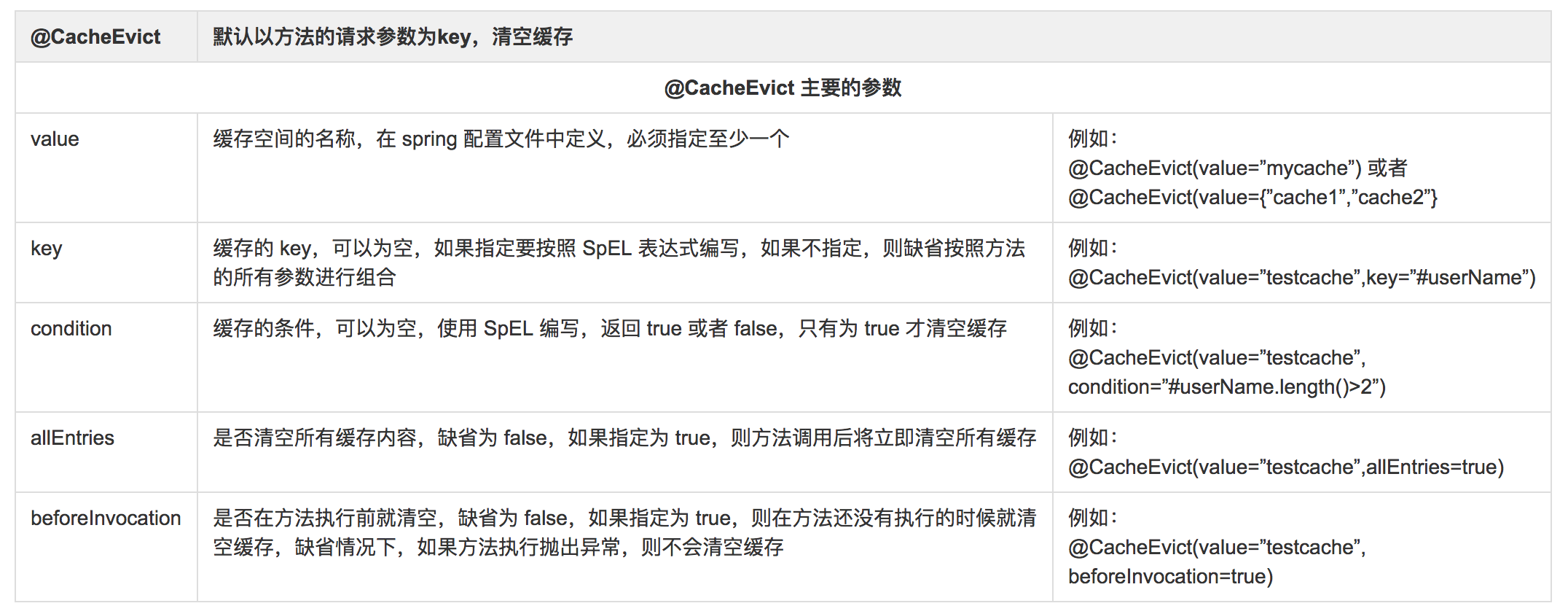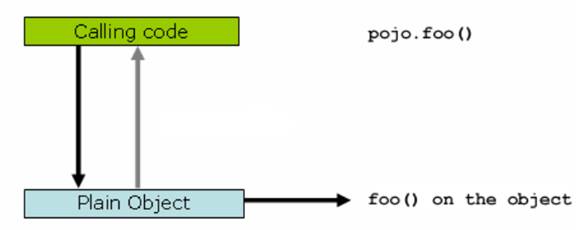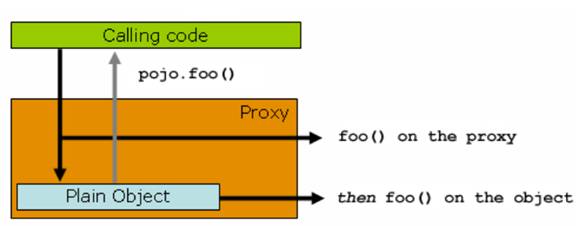Spring 源码:Spring Cache
2014-06-17
本文关注几点:
- 为什么:没有 Spring Cache 之前,如何使用缓存?Spring Cache 解决什么问题?
- 怎么用:如何使用 Spring Cache?
- 内部机制:Spring Cache 的内部实现机制?
关于缓存的通用问题(并发失效),本文暂不涉及。
1. Spring Cache之前,如何使用缓存
目标:自定义一个缓存的实现,不实用第三方组件。
场景:对查询方法做缓存(以帐号Account对象为例)
- 以账号名称为 key,账号对象为 value
- 以帐号名称为参数,查询时:
- 先查缓存,如果命中,则返回结果
- 缓存未命中,则从数据库查询,并添加缓存
- 要求缓存管理器,提供reload缓存(清空缓存)的服务
帐号对象 Account 如下:
package cacheOfAnno;
public class Account {
// 私有属性
private int id;
private String name;
// getter setter 方法
public Account(String name) {
this.name = name;
}
public int getId() {
return id;
}
public void setId(int id) {
this.id = id;
}
public String getName() {
return name;
}
public void setName(String name) {
this.name = name;
}
}
定义缓存管理器(MyCacheManager),负责实现缓存逻辑,支持对象的查询、增加、修改和删除,支持值对象的泛型。
package oldcache;
import java.util.Map;
import java.util.concurrent.ConcurrentHashMap;
// 使用泛型
public class MyCacheManager<T> {
// 缓存空间
private Map<String,T> cache =
new ConcurrentHashMap<String,T>();
// 命名为 getValue
public T getValue(Object key) {
return cache.get(key);
}
// 命名 addCache
public void addOrUpdateCache(String key,T value) {
cache.put(key, value);
}
// 命名 evictCache
public void evictCache(String key) {// 根据 key 来删除缓存中的一条记录
if(cache.containsKey(key)) {
cache.remove(key);
}
}
public void evictCache() {// 清空缓存中的所有记录
cache.clear();
}
}
实际使用场景中,需要在Service层来对Account进行增删改查操作。下面将利用MyCacheManager缓存管理器来实现一个带缓存功能的AccountService:
package oldcache;
import cacheOfAnno.Account;
public class AccountService {
private MyCacheManager<Account> cacheManager;
public AccountService() {
cacheManager = new MyCacheManager<Account>();// 构造一个缓存管理器
}
public Account getAccountByName(String acctName) {
Account result = cacheManager.getValue(acctName);// 首先查询缓存
if(result!=null) {
System.out.println("get from cache..."+acctName);
return result;// 如果在缓存中,则直接返回缓存的结果
}
result = getFromDB(acctName);// 否则到数据库中查询
if(result!=null) {// 将数据库查询的结果更新到缓存中
cacheManager.addOrUpdateCache(acctName, result);
}
return result;
}
public void reload() {
cacheManager.evictCache();
}
private Account getFromDB(String acctName) {
System.out.println("real querying db..."+acctName);
return new Account(acctName);
}
}
上述自定义的缓存方案,有一些特点:
- 缓存代码和业务代码耦合度太高:如上面的例子,AccountService 中的 getAccountByName() 方法中有了太多缓存的逻辑,不便于维护和变更
- 功能不丰富、不灵活:不支持按照某种条件的缓存,比如只有某种类型的账号才需要缓存,这种需求会导致代码的变更
- 缓存的管理器与存储空间耦合度高:不能灵活的切换为第三方的缓存模块
简单来说,自定义缓存的代码:耦合度高、易用性较差、不够灵活。
2. Spring Cache 带来的便利
注意:Spring 3.1+ 开始支持Spring Cache功能,其所需的类都在 spring-context-*.jar 包中。 利用 Spring Cache,重新实现 AccountService:
package cacheOfAnno;
import org.springframework.cache.annotation.CacheEvict;
import org.springframework.cache.annotation.Cacheable;
public class AccountService {
@Cacheable(value="accountCache")// 使用了一个缓存名叫 accountCache
public Account getAccountByName(String userName) {
// 方法内部实现不考虑缓存逻辑,直接实现业务
System.out.println("real query account."+userName);
return getFromDB(userName);
}
private Account getFromDB(String acctName) {
System.out.println("real querying db..."+acctName);
return new Account(acctName);
}
}
@Cacheable(value=”accountCache”),这个注释的意思是:
- 当调用这个方法的时候,会从命名为 accountCache 的缓存空间中查询
- 如果缓存中没有,则执行实际的方法(即查询数据库),并将执行的结果存入缓存,否则返回缓存中的对象
- 上述缓存中的 key 就是参数 userName,value 就是 Account 对象
- “accountCache”缓存是在 spring*.xml 中定义的缓存空间名称
疑问:上述缓存未命中时,查询数据库,返回对象,并将对象存入缓存?还是先存入缓存,再返回对象?合理的方式,应先返回,再存入缓存。Re:具体看AOP时,Advice 切入的时机。
启用Spring Cache的配置文件 spring-cache.xml 如下:
<beans xmlns="http://www.springframework.org/schema/beans"
xmlns:xsi="http://www.w3.org/2001/XMLSchema-instance"
xmlns:cache="http://www.springframework.org/schema/cache"
xmlns:p="http://www.springframework.org/schema/p"
xsi:schemaLocation="http://www.springframework.org/schema/beans
http://www.springframework.org/schema/beans/spring-beans.xsd
http://www.springframework.org/schema/cache
http://www.springframework.org/schema/cache/spring-cache.xsd">
<!-- 开启缓存注解 -->
<cache:annotation-driven cache-manager="cacheManager" />
<bean id="accountServiceBean" class="cacheOfAnno.AccountService"/>
<!-- generic cache manager -->
<bean id="cacheManager"
class="org.springframework.cache.support.SimpleCacheManager">
<property name="caches">
<set>
<bean
class="org.springframework.cache.concurrent.ConcurrentMapCacheFactoryBean"
p:name="default" />
<bean
class="org.springframework.cache.concurrent.ConcurrentMapCacheFactoryBean"
p:name="accountCache" />
</set>
</property>
</bean>
</beans>
关于上述Spring Cache相关的缓存配置文件,简要解释几点:
- 增加 Spring Cache的命名空间
- cache:annotation-driven,开启注解支持
- SimpleCacheManager,担当缓存管理器
- caches指定 2 个缓存存储空间:default、accountCache,都采用ConcurrentMapCacheFactoryBean
补充说明:
- cache:annotation-driven,完整的写法:cache:annotation-drivern cache-manager=”cacheManager” proxy-target-class=”true”,其中cache-manager默认值为cacheManager,可以不写。
- SimpleCacheManager内部Cache有一个缺省的实现,name=”deafult”,是基于ConcurrentHashMap实现的一个缓存区域
写一个测试代码:
package cacheOfAnno;
import org.springframework.context.ApplicationContext;
import org.springframework.context.support.ClassPathXmlApplicationContext;
public class Main {
public static void main(String[] args) {
ApplicationContext context = new ClassPathXmlApplicationContext(
"spring-cache-anno.xml");// 加载 spring 配置文件
AccountService s = (AccountService) context.getBean("accountServiceBean");
// 第一次查询,应该走数据库
System.out.print("first query...");
s.getAccountByName("somebody");
// 第二次查询,应该不查数据库,直接返回缓存的值
System.out.print("second query...");
s.getAccountByName("somebody");
System.out.println();
}
}
// 测试结果:
first query...real query account.somebody// 第一次查询
real querying db...somebody// 对数据库进行了查询
second query...// 第二次查询,没有打印数据库查询日志,直接返回了缓存中的结果
使用Spring Cache的好处:
- 缓存代码与业务代码,松耦合:只需在方法上添加注解即可
- 易用、灵活:支持增加缓存、按条件增加缓存、清空缓存
下文将简要总结一下Spring Cache提供的几个注解:Cacheable、CachePut、CacheEvict (疑问:没有Caching?)
2.1. Cacheable

2.2. CachePut

2.3. CacheEvict

2.4. Caching

3. 内部机制
Spring Cache 就是基于 AOP 实现的,在方法的调用之前、之后,分别获取方法的请求参数和返回值,进而实现缓存逻辑。

使用AOP机制之后,通过 POJO 对象的代理对象来进行方法调用,在调用前后,都可以插入缓存代码:

疑问:上述代理对象种,可以在 return 之后,再设置缓存吗? Re:不可以,因为是同步的,一定要在代理对象内方法执行 return 之前,设置缓存。
4. 扩展性
Spring Cache 是基于注释(annotation)的缓存(cache)技术,它本质上不是一个具体的缓存实现方案(例如 EHCache 或者 OSCache),而是一个对缓存使用的抽象。Spring Cache 作为缓存管理的抽象层,具有很好的灵活性和可扩展性。
基于Spring Cache,如何定制自己的缓存管理方案?
- CacheManager 接口的实现:告诉 Spring 有哪些 Cache 实例,Spring 会根据 Cache 的名字查找 Cache 的实例
- Cache 接口的实现:Cache 接口负责实际的缓存逻辑,例如增加键值对、存储、查询和清空等;利用 Cache 接口,可以对接任何第三方的缓存系统,例如 EHCache、OSCache,甚至一些内存数据库例如 memcache 或者 h2db
NOTE:Spring Cache 提供了CompositeCacheManager用于组合CacheManager,即可以从多个CacheManager中轮询得到相应的Cache,如
<bean id="cacheManager" class="org.springframework.cache.support.CompositeCacheManager">
<property name="cacheManagers">
<list>
<ref bean="ehcacheManager"/>
<ref bean="jcacheManager"/>
</list>
</property>
<property name="fallbackToNoOpCache" value="true"/>
</bean>
当调用cacheManager.getCache(cacheName) 时,会先从第一个cacheManager中查找有没有cacheName的cache,如果没有接着查找第二个,如果最后找不到,因为fallbackToNoOpCache=true,那么将返回一个NOP的Cache否则返回null。
5. 使用注意
几点:
- Spring AOP的内部调用问题:Spring Cache 利用 AOP机制实现缓存管理:通过动态生成的proxy对象进行处理,如果对象的引用是通过this的内部引用,则proxy失效,因此 Spring Cache失效
- 非public方法的问题:和Spring AOP的内部调用问题类似,如果一定要在非 public 方法上实现基于注解的缓存,必须基于AspectJ的AOP机制
- CacheEvict的可靠性问题:@CacheEvict有一个属性 beforeInvocation,默认为false,即,仅当方法成功时,才会清理缓存,如果方法内部抛出异常,则放弃清理缓存
6. 其他问题
几点:
- 缓存 null 对象:查询获得一个null对象,也是需要进行缓存的,否则,每次查询都要访问数据库,增加数据库的压力。
- 避免缓存对象的集合
- 缓存对象集合,带来了额外的数据冗余,在保证数据一致性的时候增加了复杂度;
- 缓存ID->单个对象,能够更好的复用缓存,节省cache server的内存占用
- 查询ID列表 -> 通过缓存逐个获取单个对象, 先取ID集合再根据ID取对象 产生了多次IO操作
- 主动失效 vs. 被动失效:
- 主动失效:不设置缓存失效时间,被缓存的数据发生改变的时候,主动清除缓存数据
- 被动失效:设置较短的缓存失效时间,在数据发生改变时不去刷新缓存,需要容忍一段时间的数据不一致
- 建议:由于被动失效会产生潜在bug,因此推荐采用主动失效
- 持久化 vs 缓存:一定先持久化,再添加缓存
- 新增缓存的入口:在查询时,添加缓存
- 清除缓存的入口:在更新、删除时,清除缓存
- Caching注解
- 利用 Spring Cache 如何设置缓存失效时间?Re:通常跟具体的缓存实现方案相关,例如 Redis 作为缓存时,通过调用命令 Expire 命令设置 key 的失效时间。
- SpEL(Spring Expression Language):简要梳理
备注:简单补充一点 Redis 种过期key 的清除策略:
- 惰性删除过期 key
- 定期删除过期 key
- 定时删除过期 key (Redis 中未使用)
缓存Null对象:
查询获得一个null对象,也是需要进行缓存的,否则,每次查询都要访问数据库,增加数据库的压力。Spring Cache已经实现了这一点,下面是Cache接口中 get(Object key) 的描述:
/**
* Return the value to which this cache maps the specified key.
* <p>Returns {@code null} if the cache contains no mapping for this key;
* otherwise, the cached value (which may be {@code null} itself) will
* be returned in a {@link ValueWrapper}.
* @param key the key whose associated value is to be returned
* @return the value to which this cache maps the specified key,
* contained within a {@link ValueWrapper} which may also hold
* a cached {@code null} value. A straight {@code null} being
* returned means that the cache contains no mapping for this key.
*/
ValueWrapper get(Object key);
NOTE:查询获得 null 对象,表示数据库中没有找到符合条件的记录。
7. 参考来源
- Spring Framework 4.1.x Reference
- Spring Framework 4.2.x Reference :特别说明,Spring 4.2.x 中,Spring Cache的注解,属性值有变化
- 注释驱动的 Spring cache 缓存介绍
原文地址:https://ningg.top/spring-framework-series-spring-cache/